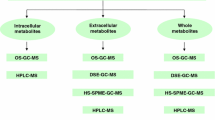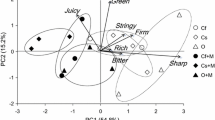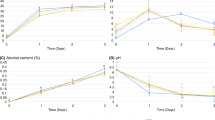Abstract
Non-volatile and volatile metabolites of 40-day fermented dongchimi, a radish water kimchi, with purified salt, solar salt (SS), and bamboo salt (BS) were analyzed using gas chromatography-mass spectrometry. Multivariate statistical analysis was used to investigate the salt effect on dongchimi quality. Dongchimi salt varieties were significantly separated from each other based on the partial least squares-discriminant multivariate statistical analysis scores plots. Sulfur compound, free sugar, sugar alcohol, and lactic acid levels, altered by salts, contributed to differences among dongchimi types. Sulfur compound levels were decreased using SS and BS, whereas the lactic acid level was increased. Fructose and mannitol levels were increased using BS and SS, respectively. A metabolic pathway associated with flavor and taste of dongchimi was proposed. The nutritional quality of dongchimi was affected by different salts.
Similar content being viewed by others
References
Park KY, Jeong JK, Lee YE, James W. Health benefits of kimchi (Korean fermented vegetables) as a probiotic food. J. Med. Food 17: 6–20 (2014)
Cheigh HS, Park KY. Biochemical, microbiological, and nutritional aspects of kimchi (Korean fermented vegetable products). Crit. Rev. Food Sci. 34: 175–203 (1994)
Lim SM, Im DS. Screening and characterization of probiotic lactic acid bacteria isolated from Korean fermented foods. J. Microbiol. Biotechnol. 19: 178–186 (2009)
Lee HS, Duffey KJ, Popkin BM. Sodium and potassium intake patterns and trends in South Korea. J. Hum. Hypertens. 27: 298–303 (2013)
Kim HJ, Chang WK, Kim MK, Lee SS, Chio BY. Dietary factor and gastric cancer in Korea: a case-control study. Int. J. Cancer 97: 531–535 (2002)
He FJ, Li J, Macgregor GA. Effect of longer term modest salt reduction on blood pressure: Cochrane systematic review and meta-analysis of randomised trials. Brit. Med J. 346: 1325 (2013)
Kim KY, Nam SY, Shin TY, Park KY, Jeong HJ, Kim HM. Bamboo salt reduces allergic responses by modulating the caspase-1 activation in an OVA-induced allergic rhinitis mouse model. Food Chem. Toxicol. 50: 3480–3488 (2012)
Nam SY, Oh HA, Choi Y, Park KY, Kim HM, Jeong HJ. Inhibition of IL-32 signaling by bamboo salt decreases pro-inflammatory responses in cellular models of allergic rhinitis. J. Med. Food 17: 939–948 (2014)
Zhao X, Song JL, Kil JH, Park KY. Bamboo salt attenuates CCl4-induced hepatic damage in Sprague-Dawley rats. Nutr. Res. Pract. 7: 273–280 (2013)
Zhao X, Deng X, Park KY, Qiu L, Pang L. Purple bamboo salt has anticancer activity in TCA8113 cells in vitro and preventive effects on buccal mucosa cancer in mice in vivo. Exp. Ther. Med. 5: 549–554 (2013)
Kang HJ, Yang HJ, Kim MJ, Han ES, Kim HJ, Kwon DY. Metabolomic analysis of meju during fermentation by ultra performance liquid chromatographyquadrupole-time of flight mass spectrometry (UPLC-Q-TOfMS). Food Chem. 127: 1056–1064 (2011)
Yang SO, Kim MS, Liu KH, Auh JH, Kim YS, Kwon DY, Chi HY. Classification of fermented soybean paste during fermentation by 1H nuclear magnetic resonance spectroscopy and principal component analysis. Biosci. Biotech. Bioch. 73: 502–507 (2009)
Namgung HJ, Par HJ, Cho IH, Chio HK, Kwon DY, Shim SM, Kim YS. Metabolite profiling of doenjang, fermented soybean paste, during fermentation. J. Sci. Food Agr. 90: 1926–1935 (2010)
Ko BK, Ahn HJ, van den Berg F, Lee CH, Hong YS. Metabolomic insight into soy sauce through (1)H NMR spectroscopy. J. Agr. Food Chem. 57: 6862–6870 (2009)
Chio HK, Yoon JH, Kim YS, Kwon DY. Metabolomic profiling of cheonggukjang during fermentation by 1H NMR spectrometry and principal components analysis. Process Biochem. 42: 263–266 (2007)
Kim J, Jung Y, Bong YS, Lee KS, Hwang GS. Determination of the geographical origin of kimchi by 1H NMR-based metabolite profiling. Biosci. Biotech. Bioch. 76: 1752–1757 (2012)
Shim SM, Kim JY, Lee SM, Park JB, Oh SK, Kim YS. Profiling of fermentative metabolites in Kimchi: Volatile and non-volatile organic acids. J. Korean Soc. Appl. Bi. 55: 463–469 (2012)
AOAC. Official methods of analysis of AOAC Intl. 15th ed. Method 960.29. Association of Official Analytical Chemists, Washington, DC, USA (1990)
Kim JH, Sohn KH. Flavor compounds of Dongchimi soup by different fermentation temperature and salt concentration. Food Sci. Biotechnol. 10: 236–240 (2001)
Jeong SH, Jung JY, Lee SH, Jin HM, Jeon CO. Microbial succession and metabolite changes during fermentation of dongchimi, traditional Korean watery kimchi. Int. J. Food Microbiol. 164: 46–53 (2013)
Calvo O, Morales J, Mercedes G. Solid-phase microextraction-gas chromatographic-mass spectrometric analysis of garlic oil obtained by hydrodistillation. J. Chromatogr. A. 1036: 91–93 (2004)
Pino J, Fuentes V, Correa M. Volatile constituents of chinese chive (allium tuberosum rottl. tiex sprengel) and rakkyo (allium chinense G. Don). J. Agr. Food Chem. 49: 1328–1330 (2001)
Johanningsmeier S, Fleming H, Thompson R, Mcfeeters R. Chemical and sensory properties of sauerkraut produced with Leuconostoc mesenteroides starter cultures of differing malolactic phenotypes. J. Food Sci. 70: S343–S349 (2005)
Zhao X, Jung OS, Park KY. Alkaline and antioxidant effects of bamboo salt. J. Korean Soc. Food Sci. Nutr. 41: 1310–1304 (2012)
Ha OJ, Park KY. Comparison of mineral contents and external structure of various salts. J. Korean Soc. Food Sci. Nutr. 27: 413–418 (1998)
Seefeldt KE, Weimer BC. Diversity of sulfur compound production in lactic acid bacteria. J. Dairy Sci. 83: 2740–2746 (2000)
Wisselink H, Weusthuis R, Eggink G, Hugenholtz J, Grobben G. Mannitol production by lactic acid bacteria: A review. Int. Dairy J. 12: 151–161 (2002)
Author information
Authors and Affiliations
Corresponding author
Rights and permissions
About this article
Cite this article
Jang, GJ., Kim, D.W., Gu, EJ. et al. GC/MS-based metabolomic analysis of the radish water kimchi, Dongchimi, with different salts. Food Sci Biotechnol 24, 1967–1972 (2015). https://doi.org/10.1007/s10068-015-0259-9
Received:
Revised:
Accepted:
Published:
Issue Date:
DOI: https://doi.org/10.1007/s10068-015-0259-9




